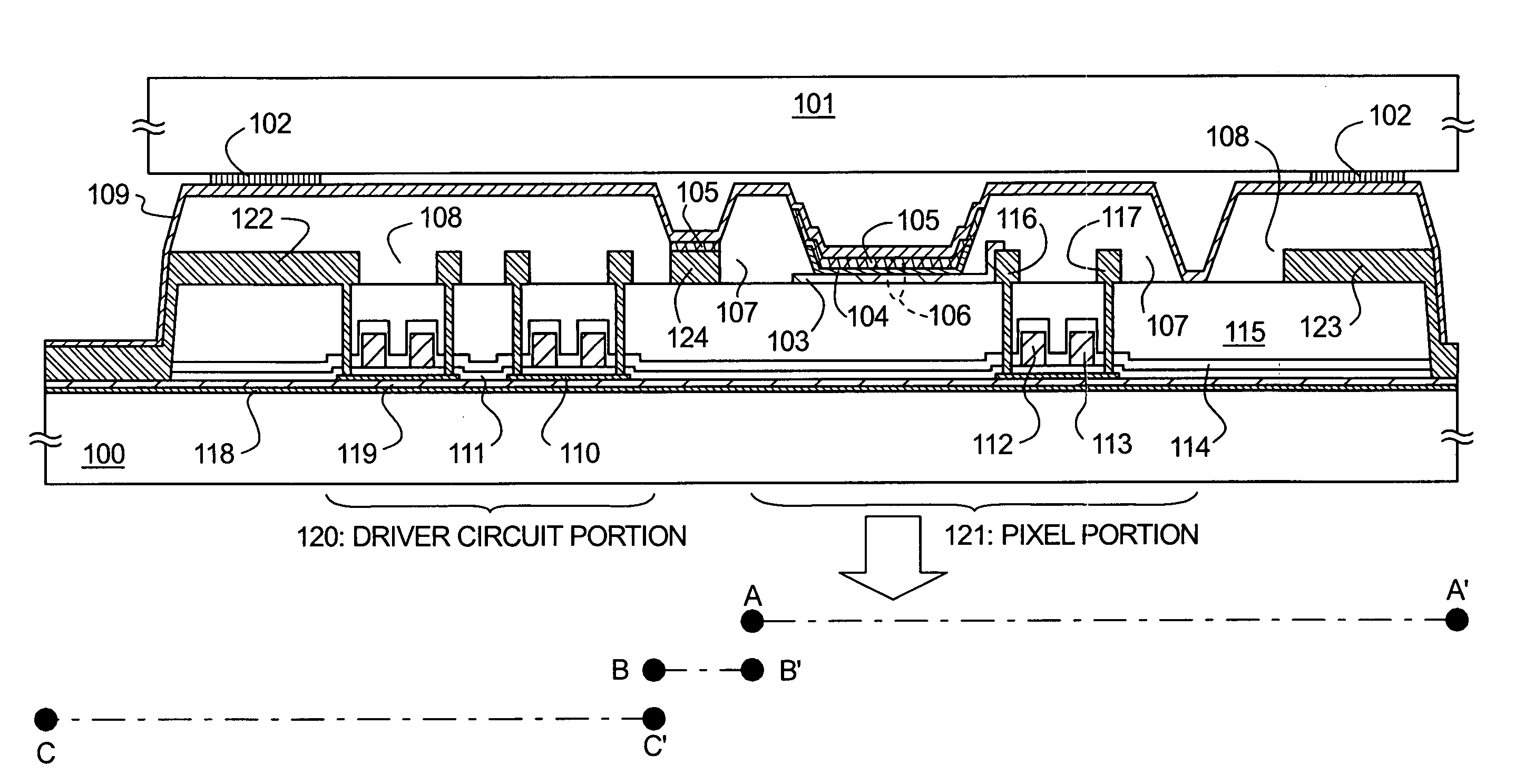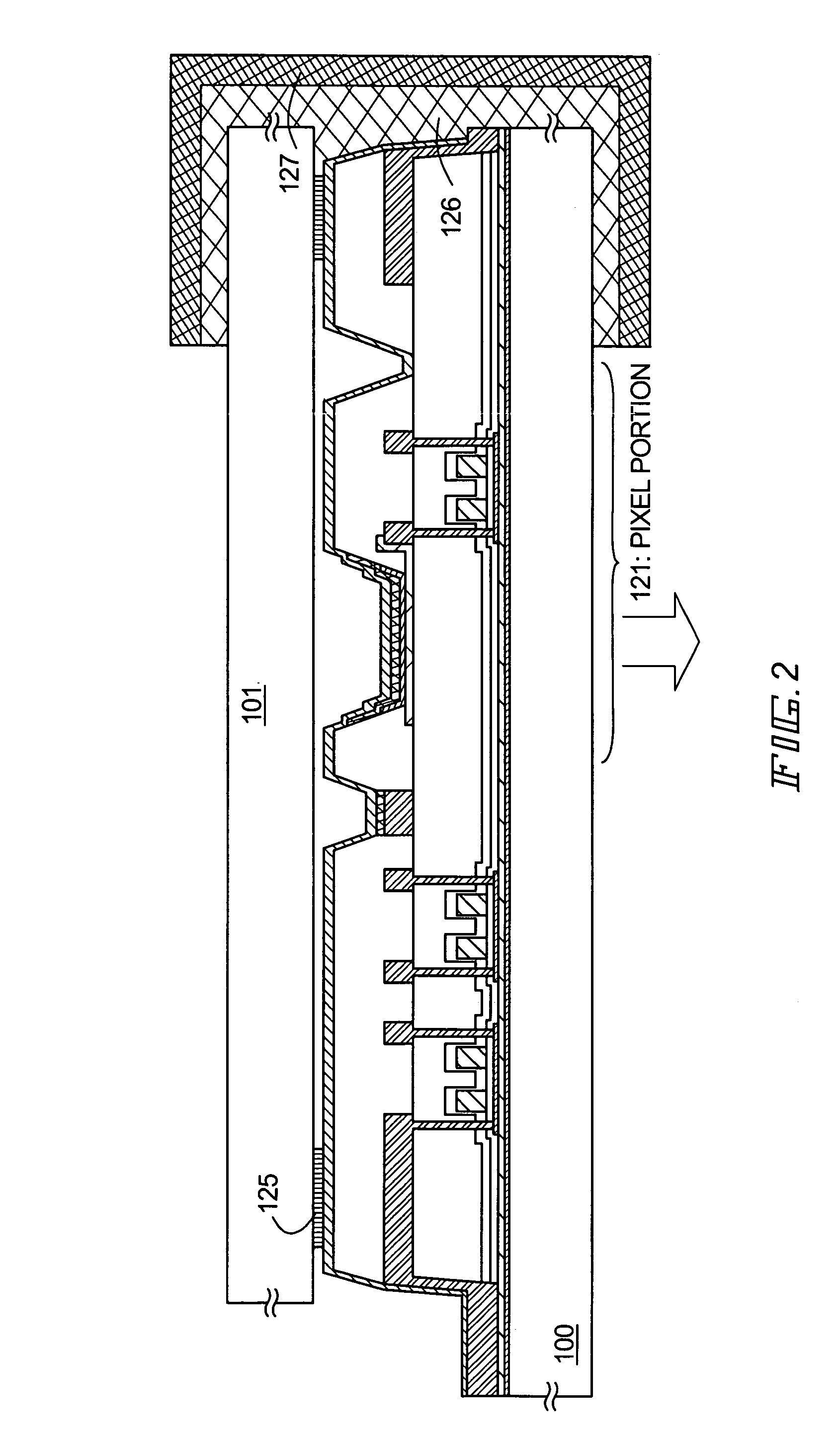Display device with sealing structure for protecting organic light emitting element
a technology of sealing structure and display device, which is applied in the direction of organic semiconductor device, discharge tube/lamp details, discharge tube luminescnet screen, etc., can solve the problems of reducing display quality, increasing the number of dark spots, and deteriorating phenomena of organic light-emitting element, so as to enhance uniformity
- Summary
- Abstract
- Description
- Claims
- Application Information
AI Technical Summary
Benefits of technology
Problems solved by technology
Method used
Image
Examples
embodiment modes
(Embodiment Mode 1)
[0052]A first embodiment mode of the present invention will be described with reference to FIG. 1. FIG. 1 is a cross-sectional view showing an active-matrix display device using an organic light-emitting element. The components constituting the display device shown in FIG. 1 will be described in the order of formation.
[0053]A driving circuit portion 120 and a pixel portion 121 are formed by using TFTs on a first substrate 100. As the first substrate 100, a substrate made of glass such as barium borosilicate glass, alumino borosilicate glass, or quartz glass is used.
[0054]The TFT in the driving circuit portion 120 and the TFT in the pixel portion 121 are provided on base films 118 and 119 having insulation properties. A silicon nitride oxide film having a thickness of 10 to 100 nm is formed as the base film 118, whereas a silicon nitride oxide film having a thickness of 20 to 200 nm is formed as the base film 119. In this embodiment mode, silicon nitride oxide film...
embodiment mode 2
(Embodiment Mode 2)
[0076]Embodiment Mode 2 will be described with reference to a cross-sectional view of FIG. 2. FIG. 2 is a cross-sectional view showing an active-matrix organic light-emitting element of Embodiment Mode 2. In Embodiment Mode 2, the display device described in Embodiment Mode 1, whose periphery is further covered with an adhesive and a metal plate 127 having a U-shaped cross section so as to prevent water from entering the organic light-emitting element, is described.
[0077]With the reference to the top plan view of FIG. 6, the adhesive and the metal plate 127 are placed so as not to overlap the pixel portion 121. In the region where the external input terminal 122 is formed so as to attach the FPC 200 thereto, the side face of the first substrate 100 and the side face of the second substrate 101 are separate from each other by 5 to 20 mm. Therefore, the adhesive and the metal plate 127 are provided in the periphery of the region where the end of the first substrate ...
embodiment mode 3
(Embodiment Mode 3)
[0081]Embodiment Mode 3 will be described with reference to a cross-sectional view of FIG. 3. FIG. 3 is a cross-sectional view showing an active-matrix organic light-emitting element according to Embodiment Mode 3. The differences from Embodiment Mode 1 will be described.
[0082]The thicknesses and the materials of the base films, the semiconductor film, the gate insulating film, the gate electrodes, and the first interlayer insulating film are the same as those in Embodiment Mode 1.
[0083]In Embodiment Mode 3, the second interlayer insulating film 115 formed of an organic resin film is thermally cured at 200 to 300° C. A resist is formed on the upper face of the second interlayer insulating film 115, and is then etched by using a reactive gas. After formation of a contact hole reaching the semiconductor film 110, the resist is removed. The surface of the second interlayer insulating film 115 is treated with a plasma using argon or nitrogen as a reactive gas. The rea...
PUM
 Login to View More
Login to View More Abstract
Description
Claims
Application Information
 Login to View More
Login to View More - R&D
- Intellectual Property
- Life Sciences
- Materials
- Tech Scout
- Unparalleled Data Quality
- Higher Quality Content
- 60% Fewer Hallucinations
Browse by: Latest US Patents, China's latest patents, Technical Efficacy Thesaurus, Application Domain, Technology Topic, Popular Technical Reports.
© 2025 PatSnap. All rights reserved.Legal|Privacy policy|Modern Slavery Act Transparency Statement|Sitemap|About US| Contact US: help@patsnap.com



